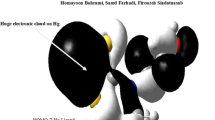Abstract
The results of MWG calculations of the electronic structures of real Co(III) complexes [Co(HD)2L1L2]nwere used to analyze the electron density distribution and to determine the charges on atoms and configurations, where nis the charge of the complex and HD is the acid residue of dimethylglyoxime (H2D); L1= NH3at L2= NH3, Cl–, Br–, or I–and L1= L2= Cl–; and L1= H2O or NO– 2at L2= NO– 2, with self-consistency over all atoms of the system and over d, s, and pconfigurations of cobalt. The mutual influence of the ligands (trans- and cis-) was shown to be determined by the atomic charges and bond orders on the axial coordinate and in the equatorial plane of the complex. The following order of the trans-effect was proposed: I–> Br–> Cl–> NO– 2> NH3> H2O. The effects of the electronic factors on distorsion and conformational processes in the complexes were discussed.
Similar content being viewed by others
REFERENCES
Chernyaev, I.I., Kompleksnye soedineniya platiny (Complex Compounds of Platinum), Moscow: Nauka, 1973.
Samus', N.M., Damaskina, O.N., and Luk'yanets, T.S., Reaktsii zameshcheniya v koordinatsionnykh soedineniyakh kobal'ta (Substitution Reactions in Coordination Compounds of Cobalt), Kishinev: Shtiintsa, 1979.
Chatt, J., Duncanson, L.A., and Venanzi, L.M., J. Chem. Soc., 1955, no. 12, p. 4456.
Orgel, L.E., J. Inorg. Nucl. Chem., 1956, vol. 2, no. 3, p. 137.
Bersuker, I.B., Zh. Neorg. Khim., 1964, vol. 9, no. 1, p. 36.
Yatsimirskii, K.B., Izv. Sib. Otd. Akad. Nauk SSSR, Ser. Khim., 1968, no. 3, p. 3.
Yatsimirskii, K.B., Zh. Neorg. Khim., 1970, vol. 15, no. 4, p. 925.
Levin, A.A., Klyagina, A.P., and Dolin, S.P., Zh. Neorg. Khim., 1979, vol. 24, no. 9, p. 2307.
Baranovskii, V.I. and Sizova, O.V., Teor. Eksp. Khim., 1974, vol. 10, no. 5, p. 678.
Baranovskii, V.I. and Sizova, O.V., Zh. Neorg. Khim., 1984, vol. 29, no. 1, p. 14.
Kukushkin, Yu.N., Reaktsionnaya sposobnost' koordinatsionnykh soedinenii (Reactivity of Coordination Compounds), Leningrad: Khimiya, 1987.
D'yachkov, P.N. and Levin, A.A., Itogi Nauki Tekh., Ser.: Str. Mol. Khim. Svyaz, 1987, vol. 11, p. 3.
Levin, A.A. and D'yachkov, P.N., Elektronnoe stroenie, struktura i prevrashcheniya geteroligandnykh molekul (Electron Structure, Structure and Transformations of Heteroligand Molecules), Moscow: Nauka, 1990.
Levin, A.A., Koord. Khim., 1993, vol. 19, no. 5, p. 368.
Vlasova, R.A., Sedova, G.N., and Kirillova, M.A., Koord. Khim., 1986, vol. 12, no. 1, p. 118.
Budnikov, S.S., Doctoral (Chem.) Dissertation, Moscow: Moscow State Univ., 1990.
Budnikov, S.S., Shkurpelo, A.I., and Simonov, Yu.A., Tezisy dokladov VII Vsesoyuznogo soveshchaniya “Fizicheskie i matematicheskie metody v koordinatsionnoi khimii” (Abstracts of Papers, VII All-Union Conf. “Physical and Mathematical Methods in Coordination Chemistry”), Chisinau: Shtiintsa, 1980, p. 101.
Shkurpelo, A.I., Cand. Sci. (Phys.-Math.) Dissertation, Chisinau: Inst. of Applied Physics, Academy of Sciences of Moldova, 1980.
Budnikov, S.S. and Spatar', F.A., Teor. Eksp. Khim., 1980, vol. 16, no. 2, p. 219.
Budnikov, S.S. and Spatar', F.A., Izv. Akad. Nauk Mold. SSR, Biol. Khim. Nauki, 1981, no. 4, p. 56.
Simonov, Yu.A., Shkurpelo, A.I., Budnikov, S.S., et al., Kristallokhimiya neorganicheskikh i organicheskikh soedinenii (Crystal Chemistry of Inorganic and Organic Compounds), Boyarskaya, Yu.S., Ed., Chisinau: Shtiintsa, 1982, p. 35.
Altti, G., Gallasso, V., Bigotto, A., and Costa, G., Inorg. Chim. Acta, 1969, vol. 3, no. 4, p. 533.
Malinovskii, T.I., Simonov, Yu.A., and Shchedrin, B.M., Kristallografiya, 1969, vol. 14, no. 6, p. 995.
Brückner, S. and Randaccio, L., J. Chem. Soc., 1974, no. T-10, p. 1017.
Simonov, Yu.A., Nemchinova, L.A., Ablov, A.V., et al., Koord. Khim., 1978, vol. 4, no. 1, p. 108.
Simonov, Yu.A., Shkurpelo, A.I., and Malinovskii, T.I., Izv. Akad. Nauk Mold. SSR, Ser. Fiz.-Tekh. Mat. Nauk, 1980, no. 1, p. 37.
Shkurpelo, A.I. and Simonov, Yu.A., Izv. Akad. Nauk Mold. SSR, Ser. Fiz.-Tekh. Mat. Nauk, 1979, no. 3, p. 46.
Bersuker, I.B. Elektronnoe stroenie i svoistva koordinatsionnykh soedinenii (Electron Structure and Properties of Coordination Compounds), Leningrad: Khimiya, 1976, p. 149.
Bresciani-Pahor, N., Calligaris, M., and Randaccio, L., Inorg. Chim. Acta, 1979, vol. 32, no. 2, p. 181.
Botoshanskii, M.M., Simonov, Yu.A., and Malinovskii, T.I., Izv. Akad. Nauk Mold. SSR, Ser. Fiz.-Tekh. Mat. Nauk, 1975, no. 3, p. 24.
Botoshanskii, M.M., Simonov, Yu.A., Malinovskii, T.I., and Simonov, M.A., Kristallografiya, 1975, vol. 20, no. 1, p. 63.
Ablov, A.V., Dvorkin, A.A., and Simonov, Yu.A., Dokl. Akad. Nauk SSSR, 1974, vol. 217, no. 1, p. 89.
Bovykin, B.A. and Chan Van Hoanh, Zh. Neorg. Khim., 1975, vol. 20, no. 6, p. 1638.
Author information
Authors and Affiliations
Rights and permissions
About this article
Cite this article
Budnikov, S.S., Shkurpelo, A.I. & Pelyakh, M.M. Nature of the Chemical Bond and the Mutual Influence of Ligands in Co(III) Dioximinates. Russian Journal of Coordination Chemistry 27, 407–413 (2001). https://doi.org/10.1023/A:1011391809690
Issue Date:
DOI: https://doi.org/10.1023/A:1011391809690



